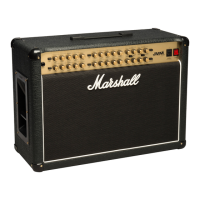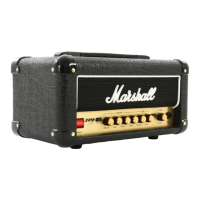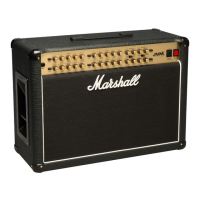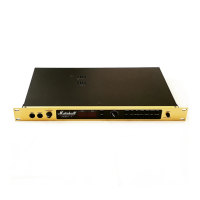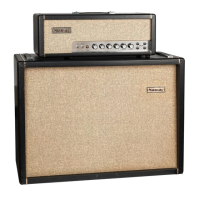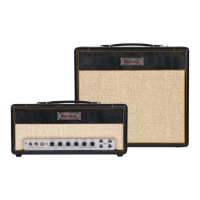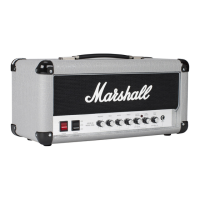ENGLISH
to instantly recall any front panel switch
funcon (Switch Store Mode) or complete
channel setup (Preset Store Mode) in any
order and combinaon.
SWITCH STORE MODE
In Switch Store mode any footswitch
buon is assigned to act as any one of the
amp’s front panel switches: CHANNEL/
MODE, REVERB on/o, MASTER 1/2 and
FX LOOP on/o.
If a footswitch buon is assigned to select
a parcular channel, once it has been
acvated that footswitch buon can be
used to scroll through the three modes,
just like its respecve front panel switch.
PRESET STORE MODE
In Preset Store mode each footswitch
buon can be programmed to instantly
call up a combinaon of front panel switch
opons to form a Preset. For example, you
could program the footswitch so that:
Buon #1 = CRUNCH channel, green
mode with MASTER volume ‘1’, REVERB
‘on’ and FX LOOP ‘o’.
Buon #2 = CLEAN channel, red mode
with MASTER volume ‘2’, REVERB ‘o’ and
FX LOOP ‘on’.
All Preset sengs are stored within the
footswitch; this means that it can be
plugged into any JVM4 amplier and your
stored footswitch sengs will be instantly
recalled.
Details on how to program your footswitch
can be found later in this manual (Front
Panel Function #10).
POWER AMP
The power-stage of the 100 Wa JVM4
is based on the one found in the JCM800
2203 and 1959 Superlead ampliers
responsible for the legendary Marshall
roar. It has been adjusted to suit the wide
variety of tones found in JVM4 channels
and modes. This power amp secon
features PRESENCE and RESONANCE
controls to help shape the overall tone of
your JVM4 amplier.
Your JVM4 is also equipped with a silent
recording mode. When the STANDBY
switch is in the OFF posion, the power-
stage is disabled, but the rest of the
amplier remains fully operaonal.
REVERB
The JVM410H and JVM410C are
equipped with studio quality reverb,
routed in parallel to the main signal and
mixed by means of a valve. When reverb
is engaged no degradaon of the direct
signal occurs and when it’s ‘o’ it is
eecvely removed from the circuit. Each
of the JVM4’s channels also has its own
dedicated REVERB level control.
The REVERB switching has been designed
to avoid abrupt cut os in the reverb tail,
so when changing from channel to channel
or switching reverb ‘o’, its tail decays
naturally.
STANDBY & SILENT RECORDING
(Front Panel Function #11)
When the amplier is in STANDBY (OFF)
the whole preamp secon connues
running at its nominal voltages whilst
the power-stage remains in a ‘standby’
status. This allows the amplier to be
used for silent recording or for preamp
purposes using the EMULATED LINE OUT
(Rear Panel Function #16).
OVERVIEW (CONT.)
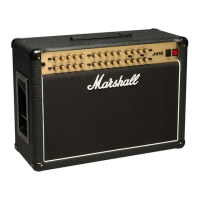
